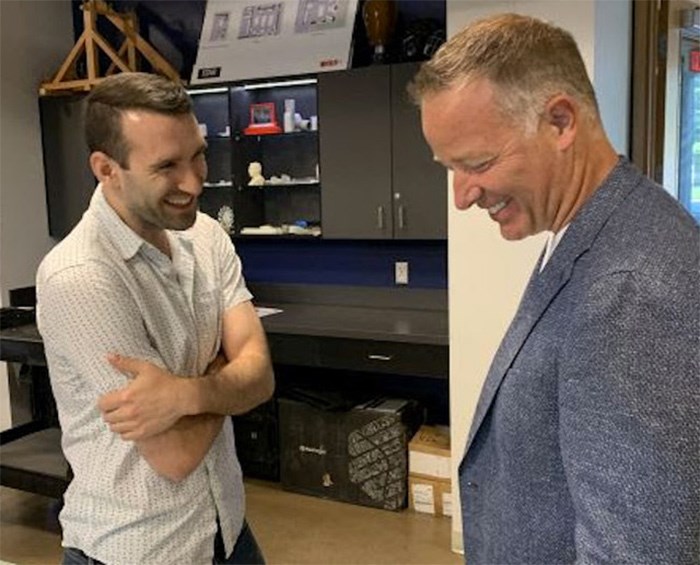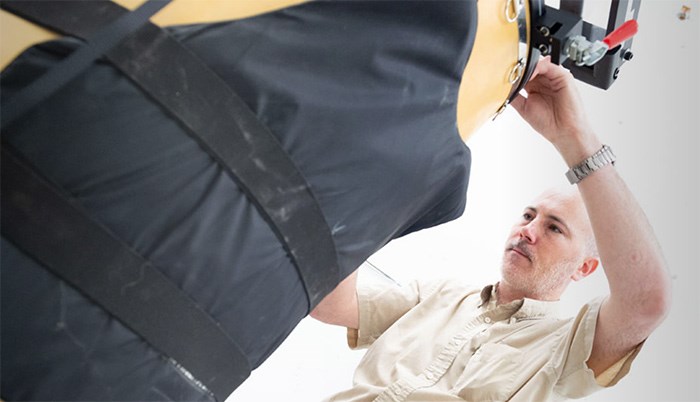 Engineering Assoc. Prof. Kevin Golovin chats with Kelowna-Lake Country MP Stephen Fuhr in the STAR Hub at UBC Okanagan. Golovin is principal investigator of the COMFORTS research network, in collaboration with researchers at the University of Alberta, University of Victoria, and industry partners. Photo: UBC Okanagan
Engineering Assoc. Prof. Kevin Golovin chats with Kelowna-Lake Country MP Stephen Fuhr in the STAR Hub at UBC Okanagan. Golovin is principal investigator of the COMFORTS research network, in collaboration with researchers at the University of Alberta, University of Victoria, and industry partners. Photo: UBC Okanagan
UBC Okanagan has been awarded $1.5 million towards researchers who are working to develop a new high-tech body armour that will protect against various threats.
“Layers are great for regulating body heat, protecting us from inclement weather and helping us to survive in extreme conditions,” said Keith Culver, director of UBC’s Survive and Thrive Applied Research (STAR) initiative.
The initiative supports a network of researchers who are working together for the next three years to create advanced clothing.
“The idea is to design and integrate some of the most advanced fabrics and materials into garments that are comfortable, practical and can even stop a bullet," said Culver.
The network is working to develop Comfort-Optimized Materials For Operational Resilience, Thermal-transport and Survivability (COMFORTS) by creating a futuristic armour solution using an intelligent and moisture-wicking base layer.
This layer is lightweight, ballistic resistant and uses a cross-linker technology, while also integrating a water, dust and gas resistant outer layer.
“Although the basic idea seems simple, binding all these different materials and technologies together into a smart armour solution that is durable, reliable and comfortable is incredibly complex,” said Kevin Golovin, assistant professor of mechanical engineering at UBCO and principal investigator of the COMFORTS research network.
“We’re putting into practice years of research and expertise in materials science to turn the concept into reality.”
COMFORTS is a collaboration between UBC, University of Alberta and the University of Victoria which is supported by various industrial partners.
The $1.5 million award came from the Department of National Defence through the Innovation for Defence Excellence and Security program.
 A ballistic torso simulator measures blunt force trauma during ballistic impact and tests novel new materials lining the vests of military personnel and first responders. Photo: UBC
A ballistic torso simulator measures blunt force trauma during ballistic impact and tests novel new materials lining the vests of military personnel and first responders. Photo: UBC
“The safety and security threats faced by our military are ever-changing,” said Culver. “Hazards extend beyond security threats from foreign forces to natural disasters now occurring more frequently than ever before."
"Almost every year we’re seeing natural disasters, forest fires and floods that put not just ordinary Canadians at risk but also the personnel that respond directly to those threats. Our goal is to better protect those who put their lives on the line to protect the rest of us.”
The COMFORTS technologies are being developed for defence and security purposes but Culver suggestions the potential for these technologies will go beyond the military.
“Imagine a garment that could keep its users comfortable and safe as they explore the tundra of the Canadian arctic, fight a raging forest fire or respond to a corrosive chemical spill,” said Culver.
“I imagine everyone from first responders to soldiers to extreme athletes being impacted by this kind of innovation in protective clothing.”
Over the next three years, eight projects will take place with some of the testing taking place at UBC’s STAR Impact Research Facility.
“I anticipate we will see some exciting new, field-tested technologies developed within the next few years,” said Culver. “I look forward to seeing where this collaboration will lead us.”


